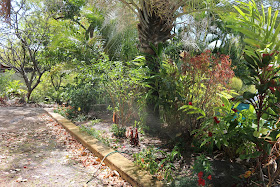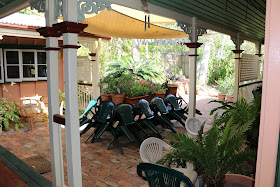Date: September 28, 2015
Season: beginning of Spring and 'dry' season
September is officially our first month of Spring. Whilst so many gardeners around Australia are rejoicing and getting back out to enjoy their gardens, the reverse is the case for me in my particular corner of this wonderful country. The enjoyable part of my gardening year is now well and truly over. Spring comes towards the latter half of our long dry season, and this year's dry season has been particularly harsh at my place.
Yes folks, that's my front yard. It's bone dry and the 'grass' (in truth, the weed patch) is an attractive shade of dead.
Our dry season is now in full swing and it's been exacerbated by the failed wet season at the beginning of the year. Usually we average somewhere around 770 mm of rain over the first three months of the year - which are our last two months of Summer and first month of Autumn. The first three months of 2015 saw an underwhelming total of just 220 mm. That amounts to a failed wet season.
The start of our dry is usually April and it can last anything up to nine months. This year's dry season has seen around 33 mm of rain fall. Yes, that's what I said ... there's been around 33 mm of rain since the end of April. For those who work in inches when it comes to rainfall - 33 millimetres is just over 1 inch of rain, 1.2 I think! So over a period of five and a half months we've had very little rain. We usually average around 82 mm / just over 3 inches between the start of April and end of September.
So, I guess the picture is becoming clearer. It's been a dry 'ole year so far, really dry! The trees in the surrounding bushland look after themselves by dropping most of their leaf load, which quickly dries up and becomes a carpet of crunchy crispy brown bits. That native grasses and groundcovers just die off, and the soil becomes rock hard very quickly. The blustery winds we often get at this time of the year also causes the ground to dry out completely. That's fine for the bushland as it will recover quite quickly when the wet season rains finally arrive.
It's a different scenario for my garden though. During most dry seasons the plants drop their leaf load or die back a little, but this year there has been more of the dying off! The plants in the various garden beds have been very thirsty for a very long time now. I've had a few losses this year and they won't be bouncing back. I've lost a couple of my Mussaendas and Acalyphas, which are usually quite tough plants.
A lot of the taller trees and shrubs drop their leaf load in the dry which creates a layer of mulch throughout the garden. Usually that's helpful in keeping some level of moisture in the soil. But without the total soaking the garden gets in a regular wet season, there's been almost no moisture in the soil whatsoever, so the mulch of lost leaves hasn't really been all that helpful.
I water sparingly in most of the garden beds, about every three to four weeks. We don't have a bore and our excess water fees are astronomical in these really dry years.
I do however put on sprinklers in the early morning or evening for a little while every few days out in the newly established garden beds. These were only just completed last year, and I've had to work hard to keep the plants going this year.
I'm really hoping that all these plants will get through the tough times and onto the next wet season, as I would love to see these beds flourish. Fingers crossed for a decent wet season in early 2016. I would love to plant more and really fill out these beds.
The lack of rain this year has also caused another issue. This dry season I've also had a really, really bad problem with a small group of Agile Wallabies that have been visiting my place. They are obviously hungry and searching for food, but this little band has decided to treat my garden plants as their daily feed. Now in previous years I've always been on their side, but my point of view has changed a little. I've never before witnessed this level of destruction caused by these wallabies in all the years I've lived on this property.
Sure, after Cyclone Yasi they did feast on a couple of plants they've never touched before. The gorgeous six-foot high Hibiscus shrub in the front garden bed suddenly became their regular treat. It's never recovered since as they still keep munching on it. But suddenly in the last few weeks the wallabies have gone beserk!
They have literally stripped back almost every cane of every Russelia clump on the property. There are quite a few clumps - around fifteen huge ones. The wallabies have nibbled on a few canes before, but now almost every cane is a stump!
The once lush-looking, always-flowering clumps are now looking very tattered and torn. The wallabies have also stripped back so many of my Hibiscus rosa-sinensis 'Snowflake' and 'Roseflake' bushes, that they now look like sticks poking out of the ground. They're a dreadful sight.
The front garden bed has been completely trampled and stripped. That sorry looking clump used to be the six-foot high Hibiscus shrub I mentioned previously. The garden bed itself was quite lovely with the several Hibiscus shrubs surrounded by always-blooming clumps of Russelia.
I've had to get in and trim back almost every plant in that front garden bed in an effort to save the poor things.
It all looks quite dreadful.
The front garden bed has been completely trampled and stripped. That sorry looking clump used to be the six-foot high Hibiscus shrub I mentioned previously. The garden bed itself was quite lovely with the several Hibiscus shrubs surrounded by always-blooming clumps of Russelia.
I've had to get in and trim back almost every plant in that front garden bed in an effort to save the poor things.
It all looks quite dreadful.
In the rock garden, the wallabies trampled down the dying-back clumps of Pennisetum as they got close to the Hibiscus shrubs behind and started stripping the leaves off the lower parts of the shrubs.
I've cut down the Pennisetum and tidied up all the broken branches of the Hibiscus and Acalypha shrubs. The rock garden bed is not looking good.
Other sections of the driveway garden beds are looking less than lovely, as the wallabies have feasted on the leaves of so many of the little shrubs trying to establish themselves.
Now while the death and destruction out in the garden beds is certainly unsettling, the destruction that has occurred in my courtyard garden is quite simply heart-breaking. Those of you who have followed my posts for a while now, will know just how much I love my courtyard garden. It's been my haven for several year and I've put a lot of effort into having lots of lovely potted colour all around the courtyard.
This was the courtyard garden about three weeks ago. Not too shabby, even though I didn't have as many potted annuals as usual for this time of the year.
There was an endless parade of birds coming in to drink the nectar of the flowers.
There were loads of bees buzzing around doing their thing.
There were lots of lovely flowers to admire as I wandered around in the morning with my cuppa.
Well, things have changed considerably in a short period of time. This is the view out onto the courtyard this morning!
I've had to pop many of the potted plants up onto the table and then set up a barricade in an effort to stop the feasting.
There's not much left around the courtyard to admire while strolling with a cuppa in hand! It just feels barren and bare to me. There's no joy to be found out there at the moment.
This is one of the main culprits, caught in the act about a week and a half ago, stipping off most of the leaves on the Cordyline plant. We attempted to scare her off with lots of noise and yelling, but she would just stand her ground and wander off when she felt like it!
Can you see the missing plant in the bottom shot? Yes, the wallabies really love Costus plants. Firstly, they stripped the stems of their leaves, then starting pulling out the stems!
I was getting crankier and crankier watching the destruction.
Luckily, most of the plants, such as this Begonia, will recover and grow back as it was just the leaves and flowers that were eaten.

But sometimes, the wallabies would knock over the pot in an attempt to get the roots as well.
This is what happened to my favourite Anthurium.
I've tried to save parts of it, but will have to wait and see if it recovers.
My favourite Caladium was also knocked over.
They weren't content with just eating the leaves. They had to get the bulbs as well.
I've got my fingers crossed that the bits I saved will bounce back and I'll see these beautiful leaves once again.
I've now got a little plant hospital out in the courtyard now! These are the things that are expected to make a full recovery.
The Anthurium and Caladium are in intensive care out in my shadehouse garden, along with a couple of other plants in dire straits. Thankfully, my shadehouse garden has not been touched. The wallabies have not yet found a way into that space.
I'm still able to enjoy some lovely colour out there.
So there you have it. It's been a while since I last posted a garden journal post and this one has been a tale of woe. Yes, I know that a lot of the plants will recover. Yes, I know the courtyard garden will reign supreme once more. Yes, I know the wallabies need to survive this long, long dry as well ... but for now I'm just wallowing a little and feeling a little down. Dry seasons are harsh on my garden, but it seems this year is going to be particularly testing. Let's hope everything just hangs in there until the wet season arrives. Hopefully that's only about four months away now.









































